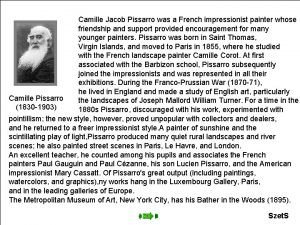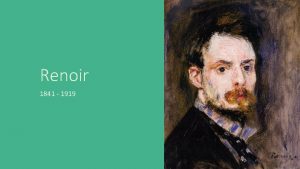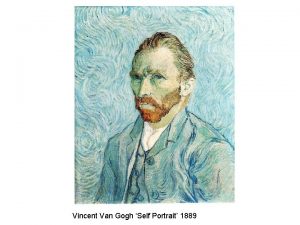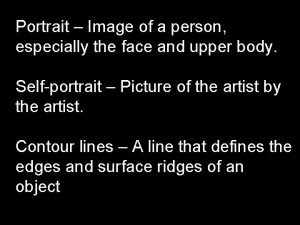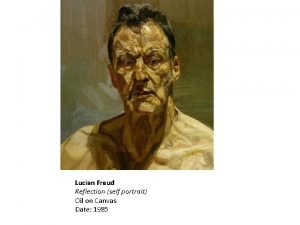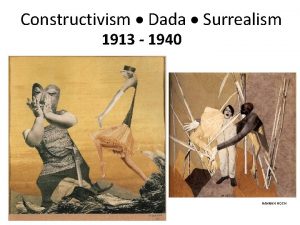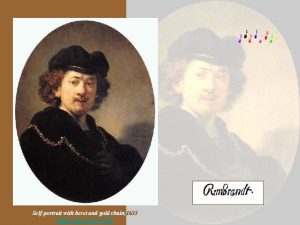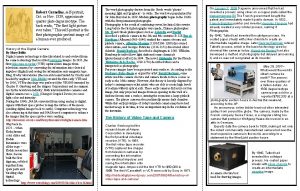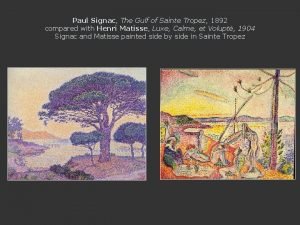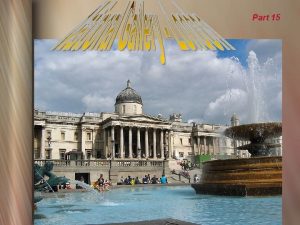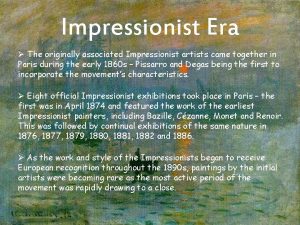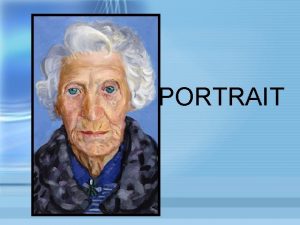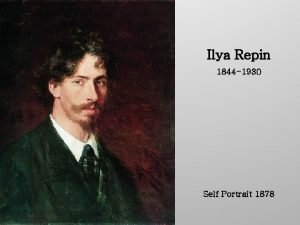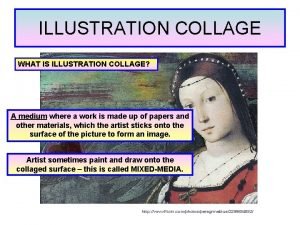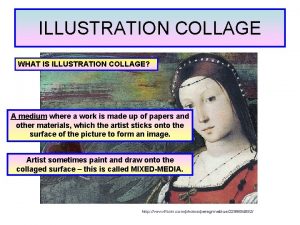Homework Impressionist Self Portrait 1 Your illustration must




































- Slides: 36

Homework Impressionist Self. Portrait 1) Your illustration must take up n n an entire sheet of white computer paper. 2) All subject matter in the painting must be illustrated using BOLD OUTLINES and ONE of the techniques below: 1. SHORT THICK“BRUSHSTROKES” 2. BRIGHT SOLID COLORS 3. DOTS (pointillism) n 3) Your illustration must use color.

n Things to Get: u The papers from the front of the room n Things to Do: u Put homework on my desk! u Opener: Review u Class work: Introduction to Impressionism: Gallery Walk u Exit Slip: Quiz on Artists and their Work u Closure: Homework Opening Agenda

Opener- Complete the questions below on your own paper. 1) The theme of G. B Shaw’s Pygmalion is what? Explain what this means. a. Religious hypocrisy and church reform b. Lustful behavior and romantic intentions c. Vengeful actions and penitent remorse d. Social inequalities and women’s rights 2) Which Norwegian playwright wrote about STD’s, marriage, and the roles of women in society? 3) What technological advancement heavily influenced the Realism movement? 4) Identify the artist, title, and the symbolic role of the person found in the middle of the canvas. In other words, what does he do for this piece? 5) Why is this piece controversial?

Impressionism

n n n Impressionis m Paris, France 1862 -86 attempted to capture the temporary effects of light and color u n n “Local color”- an object’s true color in white light rapid, sketchy brushstrokes, un -mixed paint Outdoors!, seaside, cafes and streets of Paris portray immediate visual sensations Lead by Monet, Renoir, and Cassatt

Claude Monet - Impression Sunrise

Impressionis m n Represents an attempt to capture… u a fleeting moment u Elusiveness and impermanence of images and conditions u Contemporary urban scenes

Impressionism stations n n Get into pairs 8 minutes with each poster Pass within your color. Some are black but labeled yellow, lime, etc. On the last column, tell me the following: u Subject matter u One additional supporting fact n n n Renoir Rodin Monet Cassatt Degas

Claude Monet n n n 1840 -1926 French Important Fact: u Founded Impressionism n Characteristics: u Painted same scene at different time of day and season to show effects of changing light on color n Famous works: u Water Lilies u Impression: Sunrise u Rouen Cathedral

Water Lilies

Claude Monet - Impression Sunrise

Claude Monet Impression Sunrise n n n When first exhibited, this painting was criticized for not showing an image, but merely showing “an impression” of an image. As a result, this new artistic movement was given the name Impressionism This scene shows two small boats by the sea shore. Notice how short, choppy brushstrokes are used to create this piece.

St. Lazare Station (Industrialization)

Notice the effect light has on the appearance of color

Pierre-Auguste Renoir 1841 -1919 n n n French Important Fact: n Focused on feminine sensuality Characteristics of Painting: u Delighted in people of Paris u fascinated with every day life Famous works: u Le Moulin de la Galette u The Bathers

Le Moulin de la Galette

Le Moulin de la Galette • Renoir delighted in `the people’s Paris', of which the Moulin de la Galette near the top of Montmartre was a characteristic place of entertainment, and his picture of the Sunday afternoon dance in its acacia-shaded courtyard is one of his happiest compositions. • This en plein air painting has human beings, mainly women, being the subject of this painting.

The Bathers “I consider my nude finished when I feel like smacking her bottom. ” Renoir

The Girls at the Piano

Mary Cassatt n n n 1845 -1926 American – worked in France Important Fact: u restrained by societal ideas Characteristics: u Only painted “womanly” topics – why? Famous works: u The Bath u The Boating Party

The Boating Party

The Bath (How is emphasis created in this painting? )

The Bath (How is emphasis created in this painting? ) • In The Child's Bath, the circular shapes of the figures’ heads, the basin, and the pitcher, as well as the striped pattern of the woman’s dress animate the portrait of a woman bathing a child. Cassatt’s unusual vantage point (from above) as well as her choice of a female subject show her interest in Japanese woodblock prints, which had become extremely popular in France at the time. • The many paintings, pastels, and prints in which Cassatt depicted children being bathed, dressed, read to, held, or nursed reflect the most advanced 19 th-century ideas about raising children.

Influence of Japanese artwork on Impressionism

Auguste Rodin n n 1840 -1917 French Important Fact: u Revived sculpture as an art form Characteristics of Work: u used CLUMPS of clay to create sculptures Famous works: u The Thinker u The Age of Bronze

The Thinker

The Thinker • The Thinker was originally meant to be Dante in front of the Gates of Hell, pondering his great poem. Dante as a voluptuous naked male may seem absurd to those who think of the images painted in his time and after, but Dante's head does bear some resemblance to the profile of The Thinker. Moreover, Dante's headdress is distinctive and seems to be indicated by the markings Rodin made on his working copy of The Thinker. • Why is The Thinker naked? Because Rodin wanted a heroic figure à la Michelangelo to represent Thinking as well as Poetry. • The work of Rodin resonates with the great aspirations of the 19 th century, the century of Darwin, Marx and Wagner. But in his equation, The Thinker = the Poet = the Creator, Rodin was way ahead of his time. • The Thinker was the first work by Rodin to be erected in a public place. It was inaugurated in front of the Pantheon on 21 April 1906 during an intense political and social crises which turned this sculpture into a socialist symbol.


The Age of Bronze

Edgar Degas n n n 1834 -1917 French Important Facts: u Famous for his work in painting, sculpture, printmaking and drawing Characteristics: u over half his works depict dancers Brought traditional methods of a history painter to show contemporary subject matter

The Dance Class

The Dance Class • The Dance Class was exhibited in 1876 at the second Impressionist exhibition. The subject of the work is a dance class conducted by the famous ballet master Jules Perrot. • The scene is a careful arrangement of what seems to be a random collection of postures and poses. One ballerina, who is the central focus of the composition, dances while the others mill about around her, presumably waiting their turn. • Like most of the dancers in Degas's works, these ballerinas are not performing. Degas has caught them in the unglamorous environs of the practice hall.

At the Barre


At the Bar Absinthe

Exit Slip 1 Identify the artist of each image and describe one characteristic of their style. 2 3 4
 Impressionist self portrait
Impressionist self portrait Ideal self explanation
Ideal self explanation Impressionist music period
Impressionist music period Camille french impressionist
Camille french impressionist Impressionist 1841-1919
Impressionist 1841-1919 Impressionism vs expressionism
Impressionism vs expressionism Yoga and reza ... do their homework last night
Yoga and reza ... do their homework last night Homework oh homework
Homework oh homework Homework oh homework i hate you you stink
Homework oh homework i hate you you stink Jack prelutsky homework oh homework
Jack prelutsky homework oh homework Oh homework oh homework poem
Oh homework oh homework poem Homework oh homework i hate you you stink
Homework oh homework i hate you you stink Literal language
Literal language Silhouette self portrait template
Silhouette self portrait template Andy warhol self portrait 1986
Andy warhol self portrait 1986 Torn paper drawing
Torn paper drawing Albrecht durer self portrait in a fur collared robe
Albrecht durer self portrait in a fur collared robe Charcoal self portrait
Charcoal self portrait Self portrait with monkey 1940
Self portrait with monkey 1940 Mc escher self portrait
Mc escher self portrait Self portrait (5)
Self portrait (5) Oleg shuplyak self portrait
Oleg shuplyak self portrait Self-portrait with eyes turned inward, boston
Self-portrait with eyes turned inward, boston Self portrait michelangelo
Self portrait michelangelo Michelangelo
Michelangelo Lucian freud reflection
Lucian freud reflection How to draw ears on a self portrait
How to draw ears on a self portrait Hoch
Hoch 크리스티앙 볼탕스키
크리스티앙 볼탕스키 Learning task 7 create a self portrait
Learning task 7 create a self portrait It is a self-portrait composed of many pieces
It is a self-portrait composed of many pieces Self portrait composed of many pieces
Self portrait composed of many pieces Monte carlo
Monte carlo Robert cornelius self portrait
Robert cornelius self portrait Paul signac self portrait
Paul signac self portrait Peter paul rubens
Peter paul rubens Line drawing self portrait
Line drawing self portrait



